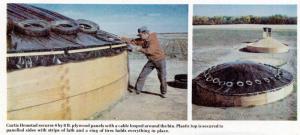1979 - Volume #3, Issue #5, Page #32
[ Sample Stories From This Issue | List of All Stories In This Issue | Print this story
| Read this issue]
Build Yourself A Plywood Grain Bin
 |
Curbs Hemstad, grain farmer near Stanley, N. Dak., has been using this idea and improving it on his own farm for several years. He willingly passes on what he's learned to FARM SHOW readers who may need extra temporary grain storage.
Basic parts of the bin are 4 by 8-ft. sheets of 3/8-in. plywood which are overlapped 6-in. and bolted together with 1 1/4 by 1/4-in. bolts at each joint. A circle of 12 sheets makes a 3,000-bu. bin; 14 sheets make a 4,000-bu. size.
When the last sheets are bolted together into a full circle, Hemstad loops a 5/16-in. cable around the bin and tightens it with a turnbuckle.
The bin must be set up on welldrained soil, he says, and sod makes a good base that won't give problems with stones and gravel. Hemstad starts the pile of grain before he sets up the bin, which makes it easier to form the plywood sheets into a perfect circle. When the paneling is in place, he fills the bin with a standard grain auger, letting it cone up naturally until the base of the pile is almost to the top of the plywood.
After the grain is safe from heating, Hemstad puts a 6-mil plastic cover over the top of the pile. He lets it lap over the plywood 6-in., then fastens it in place with wood laths.
Hemstad cautions that the grain must be dry before it is covered because the plastic forms an airtight seal and damp grain will heat. He recommends 14% moisture or lower. He has stored wheat for up to 8 months in one of these bins.
Final touch is to lay a ring of about 30 fires on the plastic, lash them together with rope, and anchor the rope in about three places. A 4,000-bu. bin should have two rows of tires.
To open a bin, Hemstad takes out a few bolts at a seam and it usually bulges open enough to insert his auger. Or, he cuts a hole with a keyhole saw. Once a bin is opened, it should be emptied without-too much delay, he points out.
There are some other "secrets" to putting up the bin that Hemstad has learned by experience. For instance, the plastic has to be put on when there is no wind, and the plywood sheets are usually assembled in sets of three before being completely attached.
Hempstad estimates cost of the temporary bin to be right at $200 for the 3,000-bu. size. When empty, the wood panels can be taken apart and stacked up for inside storage to be used again for several years. The only new expense is for the plastic.
For more details on this kind of temporary grain storage, . contact: FARM SHOW Follow, Curtis Hemstad, Stanley, N. Dak. 58784 (ph. 701 628-2714).

Click here to download page story appeared in.

Click here to read entire issue
To read the rest of this story, download this issue below or click here to register with your account number.




